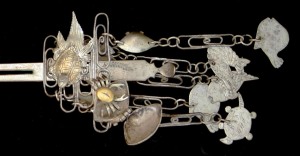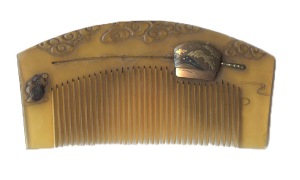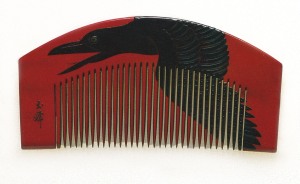By Miriam Slater:
The Japanese over the centuries have distinguished themselves by their cultivation of humor, fine design and poetry within their art. In fact, these qualities are what originally attracted me to kanzashi. As an artist I found myself entranced by the variety of expression within these beautifully crafted pieces.
Metaphors and symbols are commonly seen in Japanese hair ornaments. For example, in the top image, a silver hair ornament depicts a clamshell, a symbol that can also suggest a woman in the Floating World. When opened up, to the viewer’s surprise, in the shell is a small gold crab, pinchers ready!
The second ornament (of a similar theme) features a closed clamshell and a knife used to pry open clams. The clam’s moveable parts will open to reveal the prize within, a pearl. Symbolic objects are frequently seen on kanzashi which enhance the expression and meaning of each piece. The tortoise comb with a fishing rod can be seen as a metaphor for flirting and courtship with its implied hooking and the reeling in of one’s “catch”.
The crow, a common bird that is noisy and known for its bad manners, graces a red lacquer hair comb as an elegant adornment for a woman of position and beauty. The juxtaposition of what is considered ugly played with utmost beauty reflects the poetic side of the Japanese culture. So, to thoroughly enjoy and understand kanzashi, it really helps to see them not only as finely crafted functional objects, but also as works of art imbued with more subtle meanings.





Thank you so much Miriam! Your collection and artistic thoughts add such beauty to the world. The Creative Museum bought a crow comb from me, and everyone can see it here: http://www.creative-museum.com/content/peigne-rouge-au-corbeau-2
Oh, thats a beauty…. I also have a crow comb at http://kanzashicollector.com/artwork/1312198.html Also, I am painting a crow comb which should be ready in a week or so and will be sure to post it.
It’s a very interesting post that inspires my thoughts. In fact, I like the idea that hair ornaments can be seen as works of art in itself … Thanks – Jessica
Yes, not many people realize that combs can be considered works of art, too. The catch is that only a few of them are true works of art and a collector has to be able to discern the difference. I will do a blog soon on how to distinguish combs that are high art from those that are merely decorative.